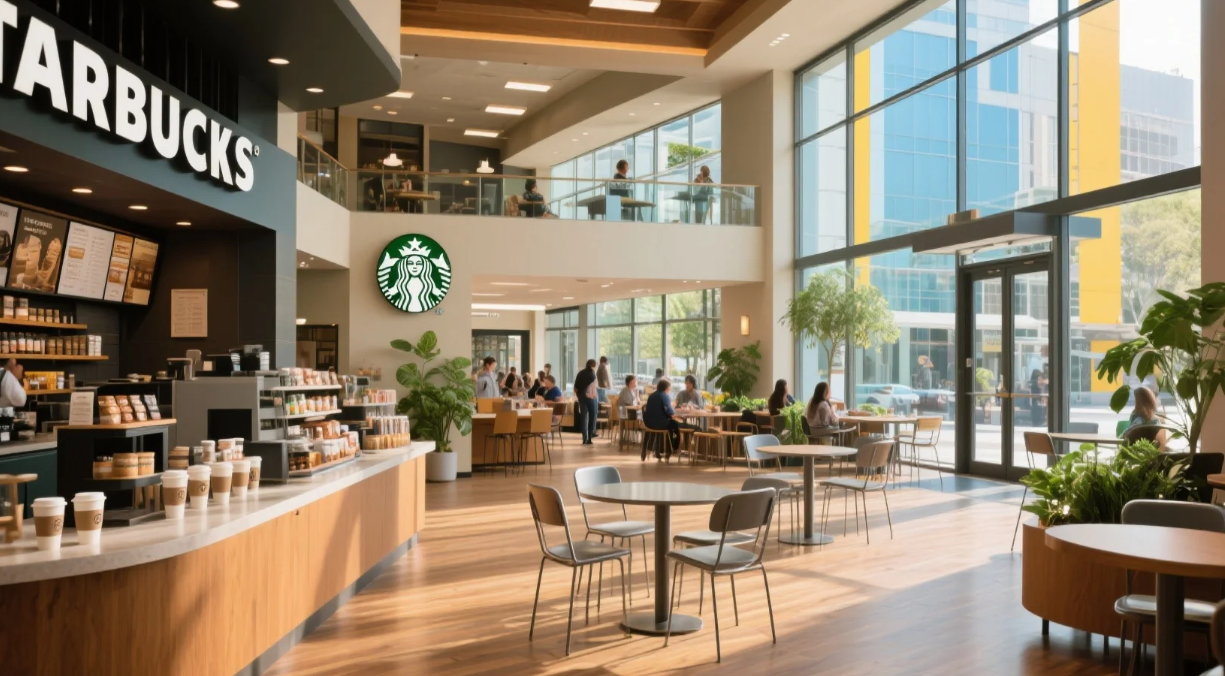Talent& Culture Strategy at Starbucks: Brewing Success Through People
Introduction
Overview of Starbucks

Starbucks started as one coffee shop in Seattle in 1971. Now, it is a big name in the coffee world. The company focuses on quality, new ideas, and caring for people. Today, Starbucks has 38,137 stores worldwide. There are 16,482 stores in the U.S. and 21,655 in other countries. These stores make about $98.56 million every day. In 2023, Starbucks earned $35.98 billion in total.
Starbucks succeeds by changing and trying new things. It runs both company-owned and licensed stores. This keeps the brand the same everywhere. The company uses ethical ways to get its supplies. Technology, like the Starbucks app, makes things easier for customers. Baristas are trained well to give great service. This training helps keep the company’s high standards.
Starbucks cares about diversity and inclusion. Women make up 30% of its factory workers. People of color (POC) hold 30% of corporate jobs, 40% of retail jobs, and 40% of factory jobs. These numbers show Starbucks’s effort to create a workplace where everyone feels valued.
HR Achievements and Recognitions
Starbucks’ focus on people has earned it many awards. It is often listed as one of the best places to work. The company builds trust and makes employees feel important. This creates happy workers who help the company grow.
Starbucks is also known for its creative HR ideas. It gives great benefits like healthcare, tuition help, and stock options. Even part-time workers get these perks. This shows Starbucks wants its employees to succeed.
Conclusion: The Foundation of a Strong Workforce
Starbucks thrives because of its people-first approach. By prioritizing employees, the company creates an environment that promotes well-being and professional growth. Inclusive workplaces like Starbucks boost employee satisfaction by 32% and improve overall wellness by 43%. This focus on building trust leads to better engagement. For instance:
Employee retention increased by 15% after engagement programs.
Turnover rates dropped significantly, fostering trust among employees.
Customer loyalty rose by 25%, reflecting the impact of great leadership.
Starbucks' commitment to its employees ensures a strong workforce that drives success.
By prioritizing its people, Starbucks has created a thriving workplace. The company's competitive benefits not only attract top talent but also ensure long-term retention. This focus on employee well-being is a cornerstone of Starbucks' success, proving that investing in people is the key to building a resilient workforce.
Starbucks understands that a thriving workforce begins with a strong company culture rooted in inclusivity and engagement. By fostering an environment where everyone feels valued, the company ensures employees contribute meaningfully to its global success. This commitment to collaboration not only strengthens the workforce but also enhances the customer experience.
When employees work in an environment that values engagement and teamwork, they are more likely to feel motivated and committed to their roles. Starbucks' focus on inclusivity and collaborative culture not only strengthens its workforce but also drives long-term growth.
Defining Talent Philosophy
Starbucks’ core principles in talent management
Starbucks builds its talent strategy on strong values. It focuses on leadership that inspires and motivates workers. This helps employees feel involved and boosts productivity by 21%, says Gallup. Starbucks also uses servant leadership, which puts the team's needs first. This builds trust and teamwork, making employees feel valued and included.
Diversity is a key part of Starbucks’ talent approach. The company works to make its workforce reflect local communities. Studies show that servant leadership improves job satisfaction and productivity. Under Howard Schultz, Starbucks grew sales to $24 billion in 2018. This success came from empowering workers with a shared vision.
Starbucks tracks performance to match efforts with company goals. Customer feedback and regular reviews help employees improve. Workers get 20 hours of training each year to grow their skills. This focus on learning and inclusion keeps Starbucks a leader in building a strong culture.
Talent Acquisition at Starbucks
Starbucks adopts a purpose-driven approach to recruitment, seeking individuals who align with its core values: community, inclusion, transparency, and growth. The company combines data-driven hiring practices with human-centric experiences to build a workforce that reflects the diversity of its customers.
To cultivate a strong talent pipeline, Starbucks employs multiple strategic approaches:
Behavior-based interviewing to assess cultural fit
Inclusive hiring panels to reduce bias
Pathways to Opportunity programs for underrepresented groups
Digital-first recruitment through social media and AI screening tools
Internal mobility initiatives promoting barista-to-manager growth
A standout program is the Starbucks Inclusion Academy, which partners with community organizations to train and hire neurodiverse talent. This initiative has expanded to 30+ U.S. locations , demonstrating how Starbucks integrates social impact with talent strategy. The company’s Hire Like Us training also equips recruiters with skills in unconscious bias mitigation and candidate experience optimization—critical competencies in today’s competitive service industry.
By blending technology with humanity, Starbucks ensures its talent acquisition practices strengthen both business performance and community connections, maintaining its reputation as an employer of choice globally.
Retention Approach at Starbucks
Starbucks knows that keeping workers is as important as hiring them. It creates a workplace where employees feel supported and included. Benefits like healthcare, tuition help, and stock options are offered to all, even part-timers. These perks show Starbucks cares about its workers.
The company helps employees grow with regular feedback and coaching. Leadership programs give workers chances to move up in the company. This focus on growth helps both employees and the company.
Starbucks’ retention strategies work well. By focusing on inclusion and worker happiness, it lowers turnover and boosts engagement. This matches Starbucks’ values and makes it a top workplace. When workers feel valued, they stay and help the company succeed.
Talent Development and Training Programs
Starbucks works hard to train its workers, called "partners." The company believes helping workers grow leads to better results. Training makes employees happier and helps Starbucks succeed over time.
New workers go through special programs to learn about Starbucks. These programs teach them the company’s values, culture, and rules. Workers also get ongoing training to improve their skills. Baristas learn how to make coffee and serve customers well. Leadership programs help workers who want to move up in the company.
Starbucks checks how well its training works using clear measures. These measures make sure training helps the company reach its goals. Below are the main things Starbucks tracks:
Metric | What It Measures |
Skill Scores | Checks worker skills before and after training to see improvement. |
Key Performance Indicators (KPIs) | Links training to company goals for better work results. |
Role Readiness Scores | Shows if workers are ready for new roles, guiding future training. |
Training Completion Rates | Tracks how many workers finish training, showing interest levels. |
Learner Engagement Scores | Measures how active workers are during training, showing their effort. |
Knowledge Retention Rates | Checks how much workers remember after training, showing its success. |
Training ROI | Compares training costs to results, showing its value. |
Employee Engagement and Satisfaction | Surveys workers to see how happy and committed they are. |
Starbucks makes training fun and easy to access. Teaching skills and leadership helps workers grow. This focus on training helps both employees and the company. When workers feel confident and supported, they do better work and help Starbucks succeed.
Employee Experience and Workplace Culture
Starbucks works hard to make employees feel happy at work. The company believes that when workers feel cared for, they do better. Happy employees give great service and help the company grow.
What Makes Starbucks’ Workplace Culture Special?
Starbucks has a culture that values teamwork, inclusion, and health. Workers, called "partners," are encouraged to be themselves at work. This helps build strong connections and keeps employees engaged. Open communication is also important, so everyone feels respected.
Starbucks shows its care for the community through its workplace. It asks workers to join local projects, which gives them purpose. This connection boosts worker happiness and builds trust with customers.
Why Employee Engagement Matters at Starbucks
Starbucks knows engaged workers are key to success. Motivated employees work harder, stay longer, and feel loyal. Studies back this up:
Fact | Source | Result |
Teams with engaged workers earn 21% more profit. | Gallup (2021) | Higher profits |
Motivated workers are 87% less likely to quit. | Harvard Business Review | Lower turnover |
Happy workers are 12% more productive. | University of Warwick | Better work results |
Starbucks uses these ideas to create a great workplace. By focusing on team goals, workers feel united. This reduces quitting and makes employees happier.
How Starbucks Cares for Workers
Starbucks offers benefits to keep workers healthy and happy. These include healthcare, mental health help, and flexible schedules. Workers also get chances to grow and learn new skills.
By caring for workers and promoting teamwork, Starbucks creates a positive workplace. Happy workers give better service and connect more with the community.
Performance Management
Performance Evaluation and Feedback
Starbucks uses a clear system to check how workers perform. It sets specific goals and uses tools to make fair evaluations. This helps workers know what they do well and where to improve.
One way Starbucks checks performance is through 360-degree feedback. This means feedback comes from coworkers, bosses, and even customers. It gives a full picture of how someone is doing. To keep things fair, Starbucks uses the same rules for everyone. These rules help avoid unfair treatment. Managers also use special dashboards to track progress. These tools show patterns and help managers support workers better.
Evidence Type | Description |
360-Degree Feedback | Gets feedback from coworkers, bosses, and customers for a full view. |
Standardized Evaluation Criteria | Uses the same rules for all workers to keep things fair. |
Performance Analytics Dashboards | Tracks progress and shows trends to help workers improve. |
Starbucks mixes numbers and personal feedback in reviews. Numbers show results, but they don’t show teamwork or creativity. Personal feedback adds details that numbers miss. By using both, Starbucks gets a complete view of worker performance.
Employee Satisfaction and Growth
Starbucks knows happy workers help the company succeed. It creates chances for workers to grow and listen to their ideas. This supports a positive workplace.
Workers at Starbucks share their thoughts through surveys. For example, 94% of workers take part in store surveys. This shows they trust the system. Starbucks listens to this feedback and makes real changes. This shows the company cares about its workers.
Statistic/Result | Description |
94% | Most workers join surveys, showing trust in the feedback system. |
Feedback Encouragement | Workers feel safe sharing ideas because they know it matters. |
Definitive Change | Feedback leads to real improvements, showing Starbucks values growth. |
Starbucks also helps workers grow in their careers. It offers leadership programs and training to help them move up. This focus on growth helps workers feel valued and stay longer. When workers see a future at Starbucks, they work harder and help the company succeed.
See Also
Discovering Opportunities with MokaHR: Your Digital Talent Solution
Achieving Hiring Success Using AI Solutions: The MokaHR Method
Enhancing Workforce Satisfaction With MokaHR’s Talent Management Platform
Effective ATS Recruitment: Empowering Your Expanding Business Strategy
Transforming Talent Acquisition Using MokaHR’s Cutting-Edge Recruitment Tools
From recruiting candidates to onboarding new team members, MokaHR gives your company everything you need to be great at hiring.
Subscribe for more information

